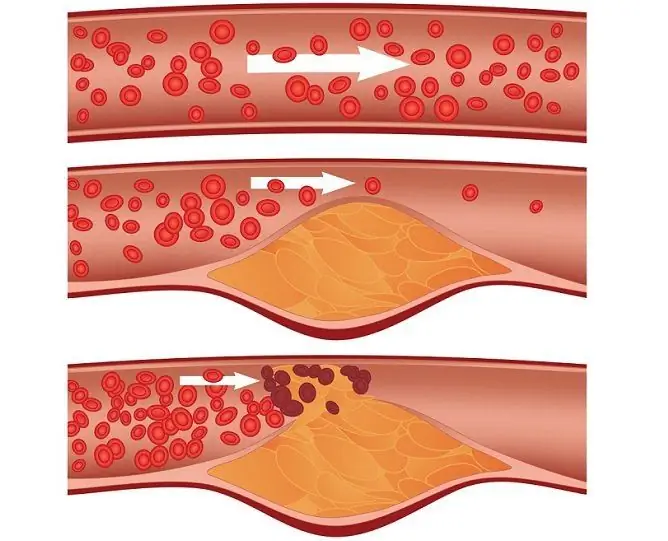- Author Rachel Wainwright [email protected].
- Public 2023-12-15 07:39.
- Last modified 2025-11-02 20:14.
Keratoma

A keratoma is a dark brown, benign skin lesion that initially looks like a freckle. Over time, the stratum corneum of the skin epithelium grows rapidly, the spot begins to horny, peel off and turns into a dark plaque. The size of the skin keratoma is 1-2 cm, the growths can be single or multiple. The disease is asymptomatic, more often it affects people over 50 years old.
Types of skin keratoma
There are several types of these growths:
- Seborrheic keratoma (or seborrheic keratosis) - appears as a brown or yellowish spot, which after a while begins to rapidly increase in size, darken and coarse. Deep cracks may appear on it. Seborrheic keratoma is not a harmless phenomenon, it is accompanied by itching, peeling and even pain. Sometimes, some of the build-up may fall off, causing bleeding. An infection can get into the wound, so if the growth is damaged, see a doctor. Keratoma of this type is a multiple formation, it can affect the area under the scalp, skin on the legs, arms, neck and face. The disease is long-term, but rarely becomes malignant;
- Senile or senile keratoma is a multiple formation with a whitish or gray tint. Age-related growths appear in people after the age of 30, usually on the neck, face, hands on the back side, less often on the stomach, back, chest and legs. After a while, the formation may increase in size and become covered with plaques. Senile keratoma is prone to inflammation, but rarely becomes malignant;
- Horny keratoma or cutaneous horn is a conical or linear formation. It has a dark color and rises 5-7 mm above the skin. Such growths can be single or multiple and occur anywhere on the body. This type of neoplasm can degenerate into a cancerous tumor, so it must be treated immediately after it appears;
- Follicular keratosis is a rather rare disease in which gray or pink nodules appear on the skin, histogenetically associated with hair follicles, reaching 1.5-2 cm in diameter. Such growths are formed in women under the hairline above the upper lip;
- Solar keratoma or ketactinic keratosis is a precancerous type of disease that affects men over 40 years old, more often fair-skinned. Neoplasms appear on areas of the skin exposed to direct sunlight, in the form of multiple dense foci of hyperkeratosis, which are covered with grayish dry scales. The disease proceeds slowly, gradually acquiring a malignant character and transforming into squamous cell carcinoma.
Keratosis causes
Keratosis is a fairly common disease. It is not contagious, but it is believed that the addiction to it is inherited. The causes of skin keratomas are varied and depend on the type of growth. It is believed that most often they are formed due to prolonged exposure of exposed, unprotected skin in direct sunlight. As a reaction to an excess of ultraviolet radiation in mature skin, there is a rapid growth of the epidermis and its further keratinization. Therefore, people with a tendency to develop keratomas should protect their skin from direct sunlight.
When keratoma becomes dangerous
Keratosis begins with a small, raised, brown or grayish patch on the skin that may flake off. Gradually, the size of the neoplasm increases, a crust appears on top. If it comes off, minor bleeding may begin, which causes the person some discomfort. Keratomas can appear in several places at once, usually in areas of the body exposed to sunlight. By themselves, they are not dangerous, and a person can live with such a build-up all his life. The danger appears when it degenerates into a malignant tumor, while the spots can grow and transform into squamous cell carcinoma. It is impossible to foresee such a transition, therefore doctors recommend immediately removing such neoplasms.
Keratoma treatment
It is important to understand that self-medication or self-removal of a keratoma is fraught with serious health consequences. Injury to the build-up can contribute to its transformation into a malignant tumor, so only a doctor should remove them. There are various treatments for keratosis:
- Cryodestruction - removal of a build-up with liquid nitrogen without anesthesia, most often used to treat senile-type keratoma;
- Laser removal is the most effective method with no contraindications;
- Radiosurgery - a non-contact method of removing a build-up using a radio knife, does not leave scars and does not damage the surrounding tissues;
- Electrocoagulation is a thermal effect on the damaged area with high-frequency current. Most often used to remove seborrheic keratomas;
- Surgery is the traditional way to remove the build-up with a standard scalpel under local anesthesia.
Treatment of keratoma with folk remedies

There are also several popular recipes for the treatment of keratosis:
- It is recommended to wipe the growths on the face with calcined warm vegetable oil to soften the roughness;
- Senile keratomas can be treated with bay leaf ointment, it slows down tumor growth and relieves pain. To do this, 6 laurel leaves are crushed into powder, a juniper leaf is added, mixed with a 12-fold volume of butter, 15 drops of fir or lavender oil are added to 100 g of the resulting mixture;
- Any type of growth can be lubricated with melted pork fat mixed with crushed dry leaves of celandine.
The use of folk remedies for keratoma should be discussed with a doctor. For the treatment to be effective, the procedures must be carried out regularly.
YouTube video related to the article:
The information is generalized and provided for informational purposes only. At the first sign of illness, see your doctor. Self-medication is hazardous to health!






